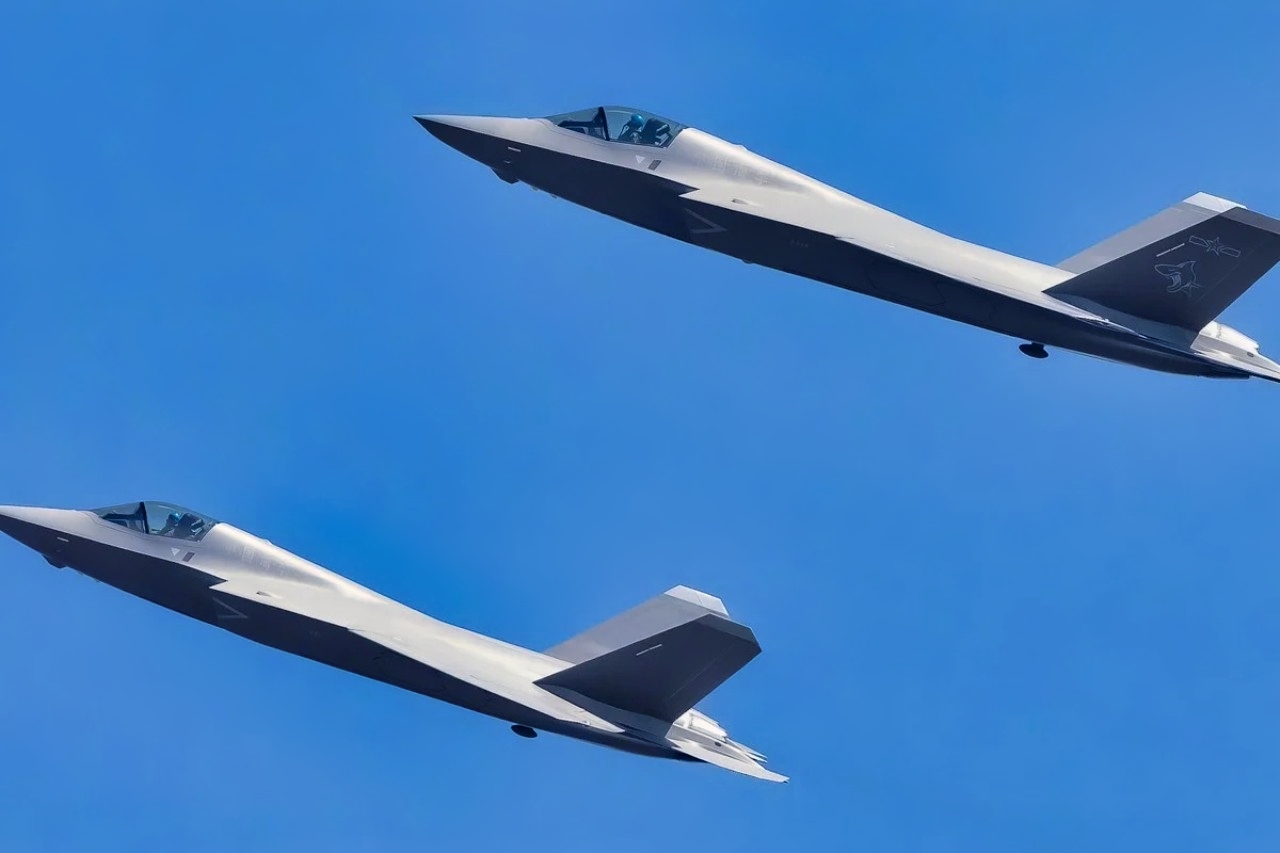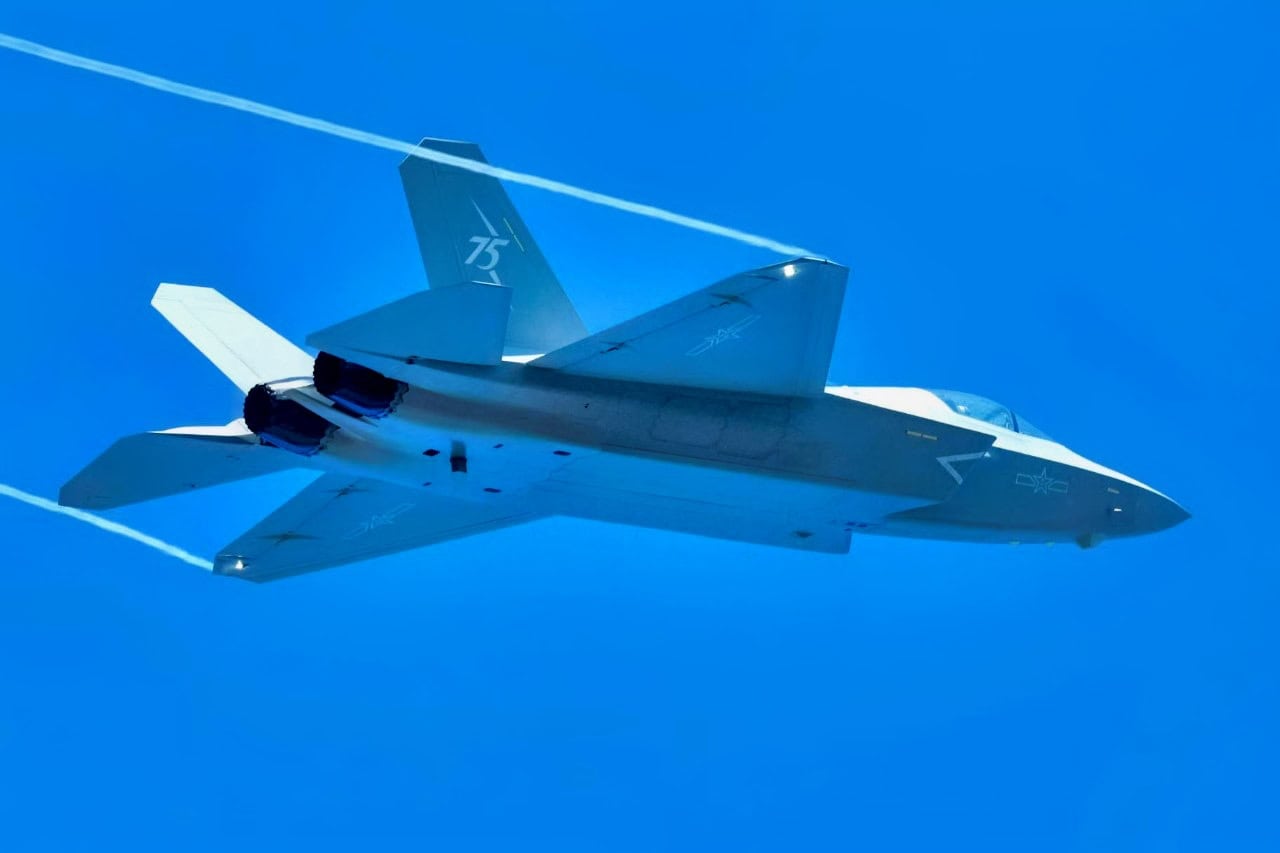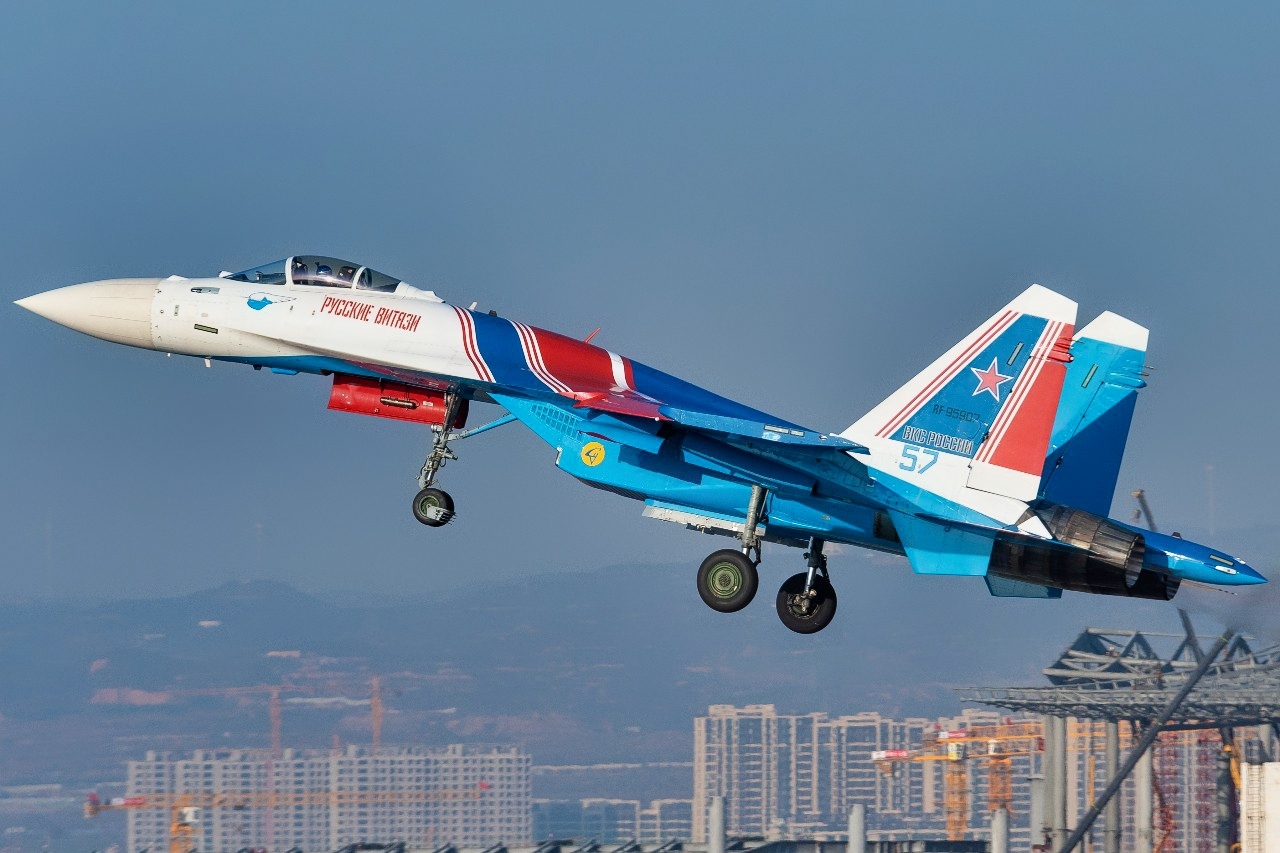Key Points and Summary – J-35 vs. Su-35: The Su-35 is Russia’s apex 4.5-gen Flanker: huge thrust, thrust-vectoring agility, long reach with Irbis-E radar and missiles like R-77/R-37M—but little stealth.
-China’s carrier-capable J-35 is a true fifth-gen design emphasizing low RCS, internal weapons, AESA radar, EOTS/IRST and sensor fusion, typically pairing PL-15/PL-10.

J-35B Government Handout Photo.
-In beyond-visual-range combat, the J-35’s stealth, low-probability-of-intercept sensing and networking likely secure first-shot opportunities.
-If the fight collapses to within-visual-range, the Su-35’s supermaneuverability and high off-boresight weapons can flip the script.
-Bottom line: J-35 advantage at BVR; Su-35 danger up close—tactics, support assets and pilot skill decide the day.
Su-35 vs J-35: Stealth or Supermaneuverability—Who Wins?
The Sukhoi Su-35 is the most advanced variant of the Soviet Su-27 Flanker. It incorporates thrust-vectoring engines and more advanced avionics in the combat-proven frame of the Su-27. The aircraft is marketed as a 4.5+ generation fighter, as many of its systems are incorporated from the Su-57 Felon.
Meanwhile, the Shenyang J-35 is China’s newest fifth-generation fighter.

Su-35. Image Credit: Creative Commons.
It features advanced stealth technology that significantly reduces its radar cross-section.
The aircraft can also operate on aircraft carriers, making it a valuable asset for the PLAN. But which of these two fighters would win in a one-on-one combat scenario?
The J-35 vs the Super Flanker
The Su-35 is a highly advanced 4.5-generation multirole fighter developed by Russia. It is an evolution of the Su-27 platform, optimized for air superiority and long-range interception. The aircraft is renowned for its supermaneuverability, enabled by thrust-vectoring engines, and its powerful radar and electronic warfare systems.
It is not stealthy by any standards, but it compensates with raw power, agility, and a large weapons payload. The Su-35 is powered by twin AL-41F1S engines, which provide high thrust and allow the aircraft to reach speeds of up to Mach 2.25.
Its Irbis-E radar system is a passive electronically scanned array (PESA) capable of detecting targets at long ranges, even stealthy ones under certain conditions. The aircraft also features an infrared search and track (IRST) system, which allows it to passively detect heat signatures from enemy aircraft.
In contrast, the J-35 is China’s second fifth-generation fighter, developed by Shenyang Aircraft Corporation. It is derived from the FC-31 and is designed for carrier operations, making it a key component of China’s naval aviation strategy.

J-35 Fighter. Image Credit: X/Screenshot.

J-35 Fighter. Image Credit: Chinese State Media.
The J-35 emphasizes stealth, sensor fusion, and electronic warfare capabilities.
It features a low observable design with internal weapons bays and radar-absorbent materials, making it difficult to detect on radar.
The aircraft is powered by twin WS-13E or WS-19 engines, which provide sufficient thrust for supersonic performance.
The J-35 is equipped with an active electronically scanned array (AESA) radar, electro-optical targeting systems (EOTS), and advanced infrared sensors.
These systems are integrated through sensor fusion, giving the pilot a comprehensive and real-time picture of the battlespace.
Stealth Capabilities: The J-35’s Strong Point
One of the most significant differences between the two aircraft is their approach to stealth and maneuverability. The Su-35 has a large radar cross-section (RCS) due to its conventional airframe and external weapons. This makes it easily detectable by modern radar systems. Its infrared signature is also high, given the powerful engines and lack of exhaust shielding.
The designers have attempted to mitigate this by adding RAM coatings to the engine inlets and the front stages of the engine compressor, but the aircraft still has an RCS of around 1-3 square meters.

Su-35. Image Credit: Creative Commons.
However, what the Su-35 lacks in stealth capabilities it makes up for in raw power and maneuverability. Additionally, the aircraft is equipped with electronic countermeasures to increase survivability.
The J-35, by contrast, has a low RCS in its frontal angles thanks to its stealth geometry and radar-absorbent coatings.
Although twin-engine fighters may still produce significant heat from rear angles, they are not as maneuverable as the Su-35. The J-35 prioritizes stealth and electronic warfare over raw agility.
Its design allows it to engage enemies without being detected, giving it a tactical advantage in beyond visual range (BVR) combat.
Avionics and Electronics: J-35 Better?
In terms of sensors and avionics, both aircraft possess advanced sensors and electronics; however, the Su-35s are slightly less advanced than their Chinese counterparts.
The Su-35 is equipped with the Irbis-E PESA radar, which boasts a long detection range and can track multiple targets simultaneously. Its IRST system allows for passive tracking, and its electronic warfare suite includes jamming and radar warning receivers.
These systems make it well-equipped for hunting and tracking enemy aircraft. However, the Su-35 lacks the sensor fusion and network-centric warfare capabilities found in fifth-generation fighters.

J-35A Fighter at Le Bourget Air Show. Image Credit: Author/National Security Journal.
Less is known about the J-35’s avionics. We do know that the aircraft features an AESA radar with low probability of intercept, electro-optical systems for passive detection, and advanced electronic warfare capabilities.
Its sensor fusion integrates data from multiple sources into a unified display, enhancing situational awareness and decision-making. This gives the J-35 a significant edge in electronic warfare environments and allows it to operate effectively in a networked battlespace.
When it comes to weapons, the Su-35 has 12 hardpoints and can carry a wide range of air-to-air and air-to-ground munitions, including the R-77 and R-73 missiles, as well as long-range R-37M missiles. It can also deploy guided bombs and anti-ship missiles.
The J-35 carries its weapons internally to maintain stealth, but can also utilize external hardpoints when stealth is not a priority, which gives the J-35 a total carrying capacity comparable to that of the Su-35. Its arsenal includes the PL-15 long-range missile and the PL-10 short-range missile, as well as precision-guided munitions and anti-ship weapons.
Who Wins in the End in 4 Words: It Depends on Context…
In any one-on-one fight, the outcome depends heavily on the engagement scenario. In a BVR engagement, the J-35 has the upper hand due to its stealth, advanced sensors, and long-range missiles.
It could detect and engage the Su-35 before being seen, giving it a first-shot advantage. The Su-35, with its larger RCS, would be vulnerable to early detection and missile strikes, although its powerful radar and missile payload could still pose a threat.
In a within visual range (WVR) dogfight, the Su-35 would fly circles around the J-35 with its highly maneuverable frame and thrust vectoring engines.
Even if the J-35 managed to lock onto and fire missiles at the Su-35, there is no guarantee of a confirmed kill. On the other hand, if the Su-35 managed to latch onto the J-35 at close range, there is little the aircraft can do if its electronic countermeasures cannot jam the missile.
About the Author: Isaac Seitz
Isaac Seitz, a Defense Columnist, graduated from Patrick Henry College’s Strategic Intelligence and National Security program. He has also studied Russian at Middlebury Language Schools and has worked as an intelligence Analyst in the private sector.
More Military
France’s Charles de Gaulle Aircraft Carrier Has a Message for Any Navy on Earth
Russia’s Last Aircraft Carrier Might Soon Be Headed to the Grave
The Navy’s Great Tomahawk Missile Crisis










